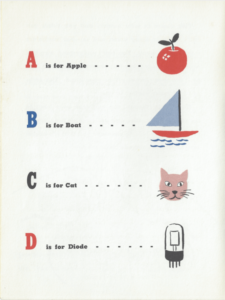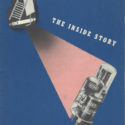A booklet for war production workers highlights gendered assumptions about technological understanding.
Originally conceived by Ruth S. Brodie during World War II, The Inside Story is a well-illustrated pamphlet given to the female workers who entered RCA’s Harrison facility to manufacture vacuum tubes for the war effort. Unlike Brodie, who had been working at the Harrison plant for some time, these new women were not well versed in manufacturing electronic components, and made mistakes that led to faulty tubes. To remedy that, The Inside Story attempted to simplify vacuum tubes to their most basic elements so that the line workers involved in their assembly could understand the importance and function of each component. While the pamphlet works under the outdated assumption that the female factory workers needed to be educated by their male superiors, it now provides a simplified explanation of vacuum tubes that anyone can follow.

The Sarnoff Collection has hundreds of vacuum tubes in its collection of all different shapes and sizes. The tubes are such a fundamental part of RCA’s radio and television inventions that we often work under the assumption that our visitors are familiar with how and why they work. By highlighting The Inside Story, we have an opportunity to go back to basics and provide a short and easy explanation of these very important components.
At their very core, vacuum tubes work because they’re filled with electrons. Those electrons are present on the cathode, which is surrounded by a grid. The cathode is heated by electricity when the device that houses the tube is plugged in. The heat excites the electrons and, in a process similar to osmosis, sends them searching for a less-populated location: the plate. They repeat this cycle, bouncing back and forth between the cathode and the plate in a line of electricity that powers the tube. In order to harness that chaotic energy in a more effective way, the grid was created to control the flow of electrons depending on the tube’s specific needs and functions. The Inside Story goes on to outline the ways in which vacuum tubes can malfunction, stressing the important role that the assembly workers play in preventing these problems. By democratizing this information, the hope was that an understanding of the vacuum tube would lead to its more careful construction.

While today The Inside Story presents a fun learning tool, its creation in the 1950s stemmed from a workplace rife with inequality. The need to explain the function of vacuum tubes in an infantilizing way suggests that the female line workers at RCA were perceived to be both ignorant to that information and incapable of comprehending it without the aid of small words and big pictures. Brodie was clear to point out that “this little book is […] not an attempt to make engineers out of everybody [and] it’s not going to begin to try to go into the complicated theory of Electron Tubes,” even though the author herself was clearly conversant with the technology. Her effort to educate the women was an admirable attempt at connecting them to the product they were responsible for assembling, but her method reveals her own internal assumptions about the women of the RCA factory.

STEM fields have come a long way since the middle of the twentieth century, although they still have a ways to go. More than ever, engineers and assembly workers alike represent an increasingly diverse array of gender, race, and class. By highlighting The Inside Story, we have an opportunity to confront the unfortunate reality of a less-diverse past, while looking towards a better future.
Text by Isabella Manusco

